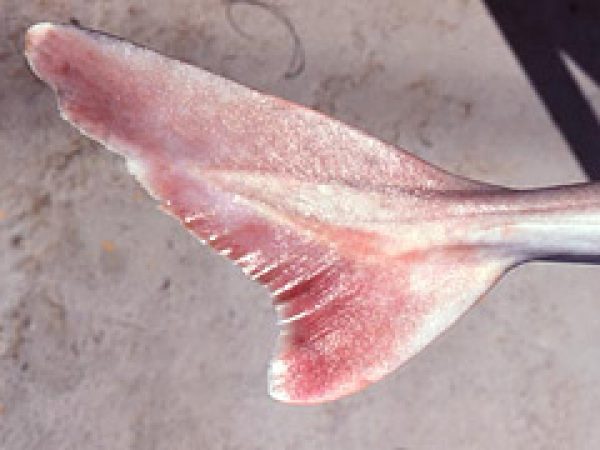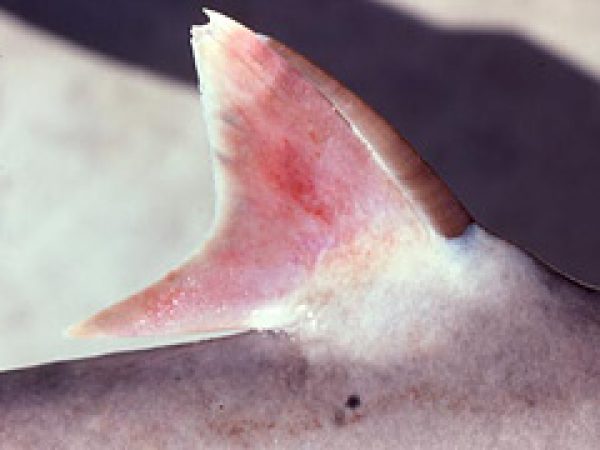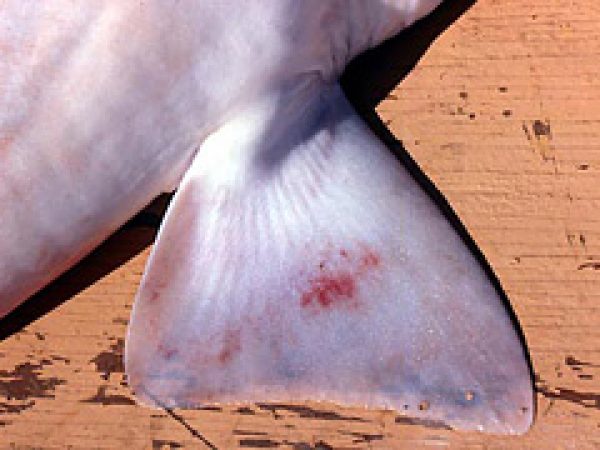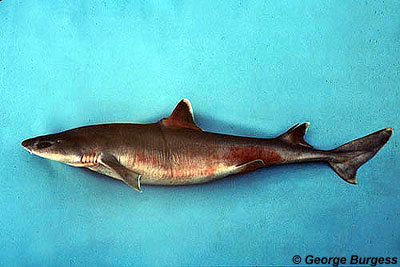
Cirrhigaleus asper
These dogfish get their name from their rough skin, caused by unusually large denticles (translated as “little teeth”) which are specialized scales designed to make sharks swim more efficiently. They have stout bodies and pointed snouts with large eyes, two dorsal fins with large spines, and a short caudal (tail) fin. This deep-water shark is dark gray-brown on top that fades to a light underbelly, with white edges on its fins. They grow to between 3 and 4 feet long, hunting smaller bony fish and cephalopods like squid.
Order: Squaliformes
Family: Squalidae
Genus: Cirrhigaleus
Species: asper
Common Names
English language common names include roughskin dogfish, roughskin dogshark, roughskin spiny dogfish, and roughskin spurdog. Common names in other languages are aiguillat à peau rugueuse (French), galludo raspa (Spanish), quelme rugoso (Portuguese), ruwe doornhaai (Dutch), and ruwevel-penhaai (Afrikaans).
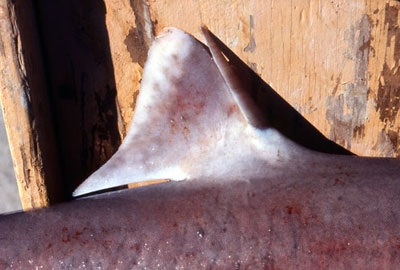
Importance to Humans
There is no interest in fisheries for the roughskin dogfish. It is occasionally caught with hook and line as well as trawling gear used in deep water.
Danger to Humans
This species of dogfish is considered harmless to humans. However, care should be taken when handling the roughskin dogfish due to the spines on the dorsal fins.
Conservation
The roughskin dogfish is listed as “Data Deficient” with the World Conservation Union (IUCN). The IUCN is a global union of states, governmental agencies, and non-governmental organizations in a partnership that assesses the conservation status of species.
> Check the status of the roughskin dogfish at the IUCN website.
Geographical Distribution
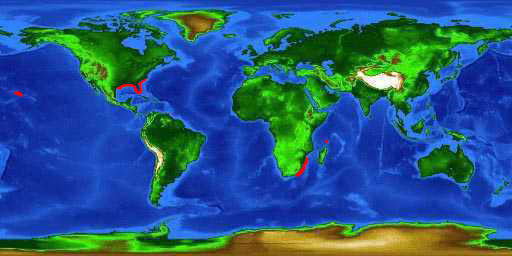
The roughskin dogfish has been reported from the western Atlantic Ocean from waters off North Carolina to the Florida Keys (US) as well as the northern Gulf of Mexico. In the western Indian Ocean, it is found from southern Mozambique to South Africa and waters off Reunion, Comoros, and the Aldabra islands. In the central Pacific Ocean, it lives off the shores of the Hawaiian Islands.
Habitat
This dogfish resides in marine waters over the upper continental and insular slopes. It is a deepwater species, found at depths from 700-1,970 feet (214-600 m). Information on the life history of the roughskin dogfish is lacking due to the recent description of this species.
Distinguishing Characteristics
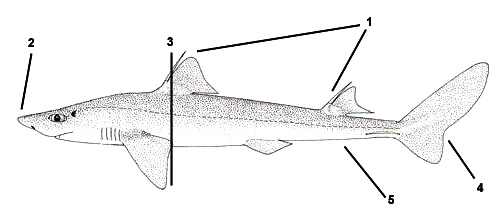
1. Two dorsal spines with very large spines
2. Snout broadly rounded
3. First dorsal spine origin behind pectoral rear tips
4. Subterminal notch on caudal fin absent
5. Anal fin absent
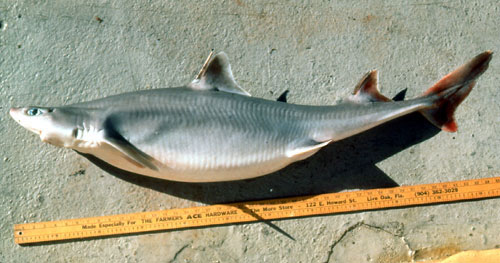
Biology
Distinctive Features
The roughskin dogfish has a stout body with a long and rounded snout. The eyes and spiracles are large. The two dorsal fins each have a spine. The first dorsal fin originates behind the free rear tips of the pectoral fins. The second dorsal fin is large, approaching the size of the first dorsal. The triangular pectoral fins are broad and have rounded tips. The caudal fin is short with broad lobes.
Other species that are similar in appearance to the roughskin dogfish include the spiny dogfish (Squalus acanthias), Blainville’s dogfish (S. blainvillei), and the Cuban dogfish (S. cubensis). The spiny dogfish can be distinguished by its small dermal denticles and second dorsal fin which is much smaller than the first dorsal. Also, it is often marked with white spots throughout the body.
The Blainville’s dogfish and Cuban dogfish both have a first dorsal fin that is located more anterior than the roughskin dogfish, with the origin over the pectoral fin. These species also have smaller dermal denticles.
Coloration
The body of the roughskin dogfish is dark gray to brown, fading to a lighter color below. The fins are edged with white. The body lacks spots or any other distinctive markings. Juvenile roughskin dogfish are brown in color.
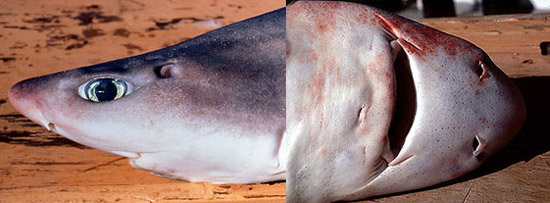
Dentition
Dentition of the roughskin dogfish consists of oblique teeth with smooth-edged cusps and distinct notches in the outer margins. Numbering 12-14 teeth on each side of the upper jaw and 11-12 teeth on each side of the lower jaw, the dentition of this species forms a practically continuous cutting edge.
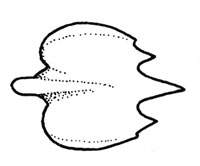
Denticles
The roughskin dogfish gets its common name from the rough feeling skin it has. This rough texture is from the unusually large dermal denticles found on this species. The denticles on adult specimens are tripcuspidate with a distinct central ridge flanked by weaker ridges. Juveniles have leaf-shaped denticles characterized by a distinct central ridge.
Size, Age, and Growth
The maximum reported size for the roughskin dogfish is 3.9 feet (120 cm) total length for a male specimen. The average size for this species is about 3 feet (90 cm). Males reach maturity at length of 2.8-3.0 feet (85-90 cm) and females mature at 2.9-3.6 feet (89-110 cm) in length.
Food Habits
This dogfish feeds on a variety of bony fishes and cephalopods including squid.
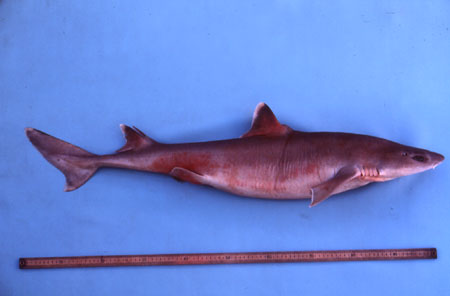
Reproduction
The mode of reproduction in the roughskin dogfish is ovoviviparity meaning the embryos are nourished by a yolk-sac within the mother’s body until birth. At the end of the gestation period, 21-22 pups are born, each measuring 9.8-11.0 inches (25-28 cm) in length.
Predators
Larger sharks are potential predators of the roughskin dogfish.
Taxonomy
Merrett described the roughskin dogfish as Squalus asper in 1973. Shortly afterwards, this name was changed to the currently valid Cirrhigaleus asper (Merrett 1973). The genus name Cirrhigaleus is derived from the Latin “cirrus” which means curl fringe and the Greek “galeo” meaning a shark. The species name asper is derived from Latin, meaning rough. Due to its recent description, there are no known synonyms referring to the roughskin dogfish in previous scientific literature.
Prepared by: Cathleen Bester
